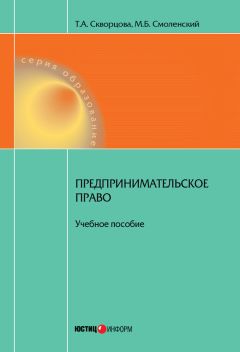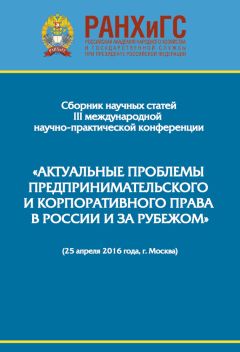Станислав Коростелев - Английский язык для юристов. Предпринимательское право

Помощь проекту
Английский язык для юристов. Предпринимательское право читать книгу онлайн
Several defenses can be used by the defendant in a negligence case. These defenses include contributory negligence, comparative negligence, and assumption of the risk.
The defense of contributory negligence involves the failure of the injured party to be careful enough to ensure personal safety. Contributory negligence completely prevents recovery by the injured party. The injured party's defense to a charge of contributory negligence is called last clear chance. Under this doctrine, a tortfeasor may be held liable if the injured party can show that the tortfeasor had the last chance to avoid injury.
The doctrine of comparative negligence requires courts to weigh the relative degree of wrongdoing in awarding damages, and to assign damages according to the degree of fault of each party.
Another defense to negligence is assumption of the risk, which involves the voluntary exposure of the victim to a known risk.
Under the doctrine of strict liability or absolute liability, the court will hold a tortfeasor liable for injuries to a victim even though the tortfeasor did not intend the harm and was not, in any way, negligent. Strict liability is generally applied when the harm results from an ultrahazardous or very dangerous activity.
Product liability is a legal theory that imposes liability on the manufacturer and seller of a product produced and sold in a defective condition (unreasonably dangerous to the user, to the consumer, or to property). Anyone who produces or sells a product in a defective condition is subject to liability for the physical or emotional injury to the ultimate consumer and for any physical harm to the user's property.
When a wrongdoer has injured another person by committing a tort, the victim can usually be compensated with monetary damages. Damages can include compensation for the repair or replacement of involved property, or for lost wages, medical bills, and any pain and suffering that the victim was forced to endure. If the tortfeasor's acts are notoriously willful and malicious, a court may impose punitive damages (exemplary damages), which are damages above and beyond those needed to compensate the injured party. Punitive damages are designed to punish the tortfeasor so that similar malicious actions are avoided by others.
If a tort involves a continuing problem the injured party may ask the court for an injunction. An injunction is a court order preventing someone from performing a particular act. If the company failed to satisfy an order, it would be in contempt of court. Contempt of court is a deliberate violation of the order of a judge that can result in a fine or in incarceration for the wrongdoer.
Exercise 1. Comprehension questions: 1. What are the kinds of violation of a duty?
2. What is done to determine if the alleged tortfeasor has met the standard of care?
3. What are the forms of the actual harm?
4. When do the courts deny damages in actions for negligence?
5. When is the strict liability applied?
6. What are the punitive damages designed for?
7. Explain what an injunction is.
Exercise 2. Find in the text English equivalents to the following:
Относительная небрежность; совместная вина; небрежность, предполагающая возмещение доли ответственности; предел возмещения; разглашение правдивых сведений позорящих другое лицо; юридически порочные условия; судебный запрет; вмешательство в контракт; нарушение личной жизни; правовая обязанность; клевета письменно или через печать; небрежность; источник вреда; непосредственная причина; убытки, присуждаемые в порядке наказания; устная клевета; объективная ответственность.
Exercise 3. Consult recommended dictionaries and give words or phrases to the following definitions:
Обязательства из причинения вреда; моральный вред; меры ответственности; вред причиненный источником повышенной опасности; вред причиненный актами власти; вред причиненный несовершеннолетними лицами; вред причиненный недееспособными лицами; вред причиненный жизни и здоровью гражданина; право регресса; способы и размеры компенсации вреда.
Exercise 4. Be ready to talk on one of the following topics:
1. Differentiate between the objectives of tort law and those of criminal law.
2. Discuss the element of duty and explain how duties relate to rights.
3. Identify the principal intentional torts and outline the elements of each.
4. Determine the four elements of negligence.
5. Contrast contributory negligence, comparative negligence, and assumption of the risk.
Exercise 5. Make up your own dialog on the case: To prove that the plaintiff died of lung cancer caused by smoking the defendant's cigarettes or that plaintiff's scalp rash was caused by the defendant hair dye will often be a tricky and difficult task. Not only must the plaintiff disclose that the breach of warranty was the cause «in fact», but he must show, that the «breach of the warranty was the proximate cause of the loss sustained.» The lawyer must prove a sufficiently close causal connection to convince the court that it ought to be defined as proximate.
Post hoc propter hoc is not normally enough; the plaintiff must show more that the goods injured the plaintiff in a certain way.
Unit 2
Characteristics, and Status of Contracts
Сущность, характеристика и статус договоров
Нормы общих положений гражданского права (раздел I ГК РФ, глава 9 «Сделки») и института обязательственного права (раздел III ГК РФ), а именно, нормы субинститута общих положений договора (главы 27, 28, 29 ГК РФ), определяют, что договор представляет собой соглашение двух или нескольких лиц об установлении, изменении или прекращении гражданских прав и обязанностей. Субъекты права свободны в определении условий, решении вопросов заключения договора и в выборе партнеров. Заключение договора проходит две стадии: 1) оферта (предложение заключить договор); 2) акцепт (согласие заключить договор). Договор может быть заключен в устной или письменной форме.
List of key terms and word combinations:– contract of record – договор, облеченный в публичный акт
– executed contract – договор с исполнением в момент заключения
– executory contract – договор с исполнением в будущем
– express contract – явно выраженный договор
– implied-in-fact contract – подразумеваемый договор
– imlied-in-law contract – квази-договор (вытекающий из предписаний закона)
– obligee – лицо, по отношению к которому принято обязательство; кредитор по обязательству
– obligor – лицо, принявшее на себя обязательство; должник по обязательству, дебитор
– privity – имущественные отношения (основанные на договоре, правопреемстве и других личных отношениях)
– promisee – кредитор по договору
– promisor – должник по договору
– quasi-contract – квазидоговор
– unenforceable contract – договор, не могущий быть принудительно осуществленным в исковом порядке
– unilateral contract – односторонняя сделка
– valid contract – надлежаще оформленный, надлежаще совершенный договор
– voidable contract – оспоримая сделка
– void contract – не имеющая юридической силы, ничтожная сделка
A contract is an agreement based on mutual promises between two or more competent parties to do or to refrain from doing some particular thing that is neither illegal nor impossible. The agreement results in an obligation or a duty that can be enforced in a court of law.
The contracting party who makes a promise is known as the promisor; the one to whom the promise is made is the promisee. The party who is obligated to deliver on a promise or to undertake some act is called the obligor. The contracting party to whom the obligor owes an obligation is called the obligee.
A legally complete contract will arise between two parties when all six elements of a contract are present: offer, acceptance, mutual assent, capacity, consideration, and legality. If any one of the six elements is missing, the transaction is not a legally complete contract.
1. An offer is a proposal made by one party to another indicating a willingness to enter into a contract. The person who makes an offer is called the offerer. The person to whom the offer is made is the offeree. Making the offer is actually the first step in creating the contractual relationship between the two parties. The offer must be seriously intended, clear and definite, and communicated to the offeree.
2. In most cases, only the specifically identified offeree has the right to accept an offer. Acceptance means that the offeree agrees to be bound by the terms set up by the offerer in the offer. In many situations, if the offeree changes any of those terms, the acceptance is not really an acceptance but a counteroffer.
3. If a valid offer has been made by the offerer and a valid acceptance has been made by the offeree, then the parties have agreed to the terms, and mutual assent exists between them. Mutual assent is sometimes called a meeting of the minds.
4. Capacity is the legal ability to enter into a contractual relationship. The law has established a general presumption that anyone entering a contractual relationship has the legal capacity to do so.
5. Consideration, i.e. the mutual exchange of benefits and sacrifices, is the thing of value promised to one party in exchange for something else of value promised by the other party. This exchange of valued items or services binds the parties together. If no consideration passes between the parties, then no contract exists.
6. The final element of a binding contract is legality. Parties cannot be allowed to enforce a contract that involves doing something that is illegal. Some illegal contracts involve agreements to commit a crime or to perform a tort. Other activities that are neither crimes nor torts have been made illegal by specific statutes. Among these activities are usurious agreements, wagering agreements, unlicensed agreements, unconscionable agreements, etc.
All contracts are agreements, but not all agreements are contracts. An agreement may or may not be legally enforceable. For example, an agreement to take a friend to a football game would not be legally enforceable because the friend has not given anything in exchange for that promise. To be enforceable, an agreement must conform to the law of contracts.
The general rule of contract law is that the parties to a contract must stand in privity to one another. Privity means that both parties must have a legally recognized interest in the subject of the contract if they are to be bound by it. Outside parties who do not have such an interest in the subject matter of the contract may not be bound by it. Their right to sue in the event of breach (i.e., broken or violated) of contract would also be called into question. An exception to the general rule of privity exists in cases involving warranties and product liability.
Contractual characteristics are divided into four different categories:
• valid, void, voidable, and unenforceable;
• unilateral and bilateral;
• express and implied; and
• informal and formal.
Any given contract could be classifiable in all four ways. Thus, a single contract could be said to be valid, bilateral, express, and formal.
A valid contract is one that is legally binding and fully enforceable by the court. In contrast, a void contract is one that has no legal effect whatsoever. A contract to perform an illegal act would be void. A voidable contract is one that may be avoided or canceled by one of the parties. A contract made by minors and one that is induced by fraud or misrepresentation are examples of voidable contracts. An unenforceable contract is one that, because of some rule of law, cannot be upheld by a court of law. An unenforceable contract may have all the elements of a complete contract and still be unenforceable.
A unilateral contract is an agreement in which one party makes a promise to do something in return for an act of some sort. In contrast, a bilateral contract is one in which both parties make promises. A bilateral contract comes into existence the moment the two promises are made. A breach of contract occurs when one of the two parties fails to keep the promise.
A contract can be either express or implied. An express contract requires some sort of written or spoken expression that indicates the desire of the parties to enter the contractual relationship. An implied contract is created by the actions or gestures of the parties involved in the transaction.

























